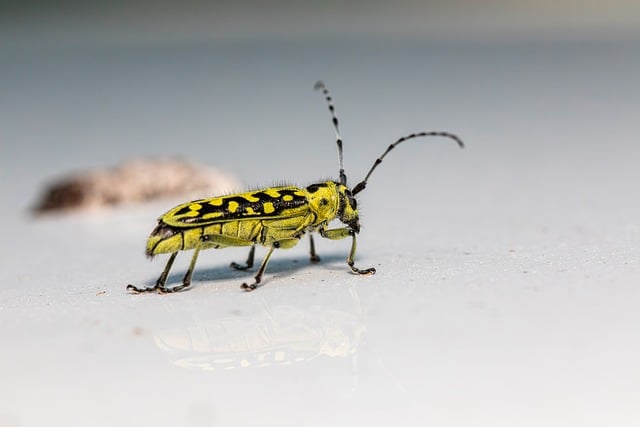Stinging pests like wasps, hornets, and bees pose health risks, requiring professional stinging pest control services. Experts use advanced tools, such as telescopes, thermal imaging, and listening devices, to identify and locate nests in residential and commercial settings. They employ strategies like carbon dioxide traps and pheromone monitoring for effective stinging insect extermination. After eradicating nests through safe and strategic methods, professionals implement preventive measures and regular inspections to deter future infestations, offering both residential stinging pest services and commercial stinging pest removal solutions.
In the realm of pest control, stinging insects like wasps and bees pose a unique challenge. To ensure safety and maintain a comfortable living or working environment, thorough inspections are crucial. This article guides you through understanding stinging pest behavior, mastering tools for comprehensive inspections, identifying nesting signs, and implementing effective extermination strategies. Whether it’s for residential or commercial spaces, these insights will help you tackle stinging insect issues with professional wasp removal and bee and hornet control services in mind.
Understanding Stinging Pest Behavior: When and Where They Nest
Stinging pests, including wasps and hornets, are social insects that live in colonies with a complex social structure. Understanding their behavior is crucial when it comes to identifying nesting areas and implementing effective stinging pest control services. These insects typically nest during the warmer months when food sources are abundant. They prefer sheltered locations, such as under eaves, in attics, or within hollow trees (for outdoor nests) and wall voids, crawl spaces, or behind paneling inside homes and commercial buildings.
Professional wasp removal experts know that stinging insects often build nests in areas where there is easy access to both shelter and food sources. Bee and hornet control measures are essential for residential and commercial properties alike, as these pests can cause significant distress and even pose health risks to individuals with allergies. Stinging insect extermination requires specialized equipment and knowledge to safely remove nests and prevent re-infestation, ensuring that pest control for stinging insects is effective and thorough.
Tools and Techniques for Comprehensive Inspections
Comprehensive inspections require a multi-faceted approach to effectively identify stinging pest nesting areas. Professional wasp removal and bee and hornet control services often employ a combination of tools and techniques, including high-powered telescopes, thermal imaging cameras, and specialized listening devices. These tools enable experts to detect nests hidden in hard-to-reach places, such as roof spaces, walls, and even within decorative features.
For residential stinging pest services and commercial stinging pest removal, trained technicians utilize their expertise to assess the unique challenges posed by different structures. They carefully inspect exterior areas for signs of activity, including pupal cases, worker trails, and nest locations. Additionally, they may use carbon dioxide traps and pheromone monitoring systems to lure out insects and gather data on their presence and behavior. This meticulous process ensures that every potential nesting area is thoroughly evaluated, allowing for the most effective stinging insect extermination strategies.
Identifying Nesting Areas: Signs to Look For
Identifying where stinging pests like wasps and bees choose to nest is a crucial step in effective stinging pest control services, whether for residential or commercial properties. Professional wasp removal experts look out for specific signs that indicate the presence of nests. These include visible clusters of insect activity, such as rapid movement in and out of a particular area, often near entry points like doors, windows, or vents. Nesting areas can vary; wasps, for instance, prefer secluded spots with easy access to the outdoors while bees are more inclined towards cavities, attics, or even wall voids.
One key sign to watch out for is chewed-through materials, like wood or plastic, as these pests create nests from a variety of natural and man-made substances. Additionally, swarms of stinging insects flying around a specific area may indicate an active nest nearby. Bee and hornet control specialists employ their knowledge of pest behavior to carefully assess these signs, enabling them to pinpoint and eradicate nests efficiently, ensuring safety for both the property owners and the professionals providing stinging insect extermination services.
Effective Strategies for Exterminating Stinging Pests and Preventing Recurrence
Effective strategies for exterminating stinging pests and preventing recurrence involve a multi-faceted approach. Professional wasp removal and bee and hornet control services should be called upon to identify and eliminate nests using specialized equipment and treatments that are safe and effective. These experts can navigate complex residential or commercial stinging pest services, ensuring every nest is located and destroyed.
Post-extermination, implementing preventive measures is crucial. This includes sealing entry points, repairing damaged screens, and maintaining proper sanitation practices to minimize attractants. Regular inspections by trained professionals are recommended, especially in areas prone to stinging insect activity, to catch any early signs of reoccurrence and provide prompt stinging insect extermination.
Comprehending stinging pest behavior and utilizing effective inspection techniques are key to addressing these pests. By identifying nesting areas through discernible signs, property owners and professionals alike can employ strategic extermination methods, ensuring safety and preventing reoccurrence. For comprehensive solutions tailored to residential or commercial settings, enlisting the help of professional stinging pest control services, including bee and hornet control and wasp removal, is recommended. These experts utilize advanced tools and techniques for effective long-term management, providing peace of mind in a world where these insects can cause severe discomfort and even pose health risks.
